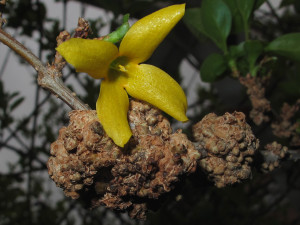




Modified crops such as Golden Rice could have major benefits for people in developing nations. Image credit: IRRI Licensed under CC BY 2.0
By David Zilberman, Professor and Robinson Chair, Agriculture and Resource Economics, UC Berkeley
When I started working on agronomical issues in the 1970s, the most exciting technologies were related to water, machinery, and harvesting. Plant genetics seemed to be quite a boring enterprise. But as I became familiar with the Green Revolution, I realized the importance of plant research, and that the golden rule in agriculture is to find the optimal mixture between biotic and abiotic technologies. As an economist working on technology, I started to realize that the past fifty years have drastically changed the way plant sciences are done, and the potential and value of their product.
The discovery of the innerworkings of a cell, combined with the power of computers and precision tools, has changed medicine, but it has perhaps the potential to make an even bigger impact on plant sciences and agriculture. I have been working on the economics and policy aspects of agricultural biotechnology (see also Journal of Economic Perspectives). Despite the restrictions on genetically modified varieties, they increase yields and make food more affordable for the poor. They also reduce greenhouse gas emissions and actually improved human health (by reducing exposure to chemicals and aflatoxin). But biotechnologies have had limited impact because of regulations that limit their use mostly to feed and fiber crops, and the practical ban on use of GMOs in Europe and parts of Africa.
It’s clear that developing countries can be the major beneficiaries of these technologies. They can save billions of dollars and address severe health and malnourishment problems. Furthermore, applications of biotechnology on food crops can reduce food security problems and increase access to valuable fresh produce throughout the world. Modern biotechnology can provide tools to accelerate adaptation to climate change, and I am surprised that some of the organizations most aware of climate change don’t recognize the value of biotechnology to address it.
Plant science research has already made major achievements using traditional and advanced tools to provide better varieties and improve the global food situation in a world with a fast growing population. There is a large body of literature documenting the rate of return of research, and much of the achievements have been the development of new varieties. The literature suggests that public research that provided much of the benefit has been underfunded, and its funding is declining. Thus, plant research hasn’t reached its potential.
Thus far, applied research in plant sciences at many universities concentrate on grasses, like corn and wheat, but underemphasize trees and algae. One explanation to the emphasis on grasses is the immediate economic benefits they seem to provide. With all the modern tools of biology, the big challenges and some of the most radical and relevant knowledge can come from the study of trees and algae within the context of forest and oceans. Studies of these specimens will enhance our understanding of living systems, is crucially important from a macro-ecological perspective, and from a practical perspective of finding new materials, new foods and efficient sources of energy.

Poplar is one of the most commonly used trees in plant science research. Image credit: Walter Siegmund
I believe that society tends to underinvest in plant sciences, both because science is underfunded in general and because of the regulations of biotechnology that limit their use, as mentioned above. The contribution of plant scientists to address problems of climate change, deforestation, food security, and environmental quality are under-emphasized and under-recognized. This leads to less investment in this area, less contribution, and less student interest. But more investment in plant sciences may provide better understanding of their impact and how to regulate them, and provide more promising applications. So we are in a vicious cycle of over-regulation and under-funding that mostly hurt regions and populations that are vulnerable, and reduce our capabilities to deal with global changes.
To move forward, we need to have more enlightened regulations that will allow us to take advantage of this incredible science and big jolts in terms of support for research in plant sciences. Enlightened regulations would balance benefits and risks, reduce the cost of access to modern biotechnologies. They also would allow efficient and mutually beneficial transfer of knowledge and genetic materials across locations. Plant sciences is one discipline where the distribution of efforts across locations globally can be especially beneficial as we can learn about the performance of plant systems throughout the world. Therefore, investments in plant sciences should be distributed globally. For example, a major effort to raise funding for 100 Chairs of Plant Sciences around the world, especially in developing countries, will be a good start. It should be associated with support for student research, as well as forums the exchange of new ideas. And finally, new investments in arboretums and greenhouses.
Plant sciences have been providing humanity essential knowledge that enabled the growth and evolution of human civilization without much fanfare. New tools increase its potential and the excitement and value of research in these areas. Society needs to expand their support to plant sciences to enable it to flourish around the world, as well as enlightened regulation to gain benefits from the fruits of this research.
New Breeding Technologies in the Plant Sciences – Applications and Implications in Genome Editing
Gothenburg, Sweden, 7-8th July 2017
REGISTRATION FOR THIS MEETING IS NOW OPEN!
Organised by: Dr Ruth Bastow (Global Plant Council), Dr Geraint Parry (GARNet), Professor Stefan Jansson (Umeå University, Sweden) and Professor Barry Pogson (Australian National University, Australia).
Targeted genome engineering has been described as a “game-changing technology” for fields as diverse as human genetics and plant biotechnology. Novel techniques such as CRISPR-Cas9, Science’s 2015 Breakthrough of the Year, are revolutionizing scientific research, allowing the targeted and precise editing of genomes in ways that were not previously possible.
Used alongside other tools and strategies, gene-editing technologies have the potential to help combat food and nutritional insecurity and assist in the transition to more sustainable food production systems. The application and use of these technologies is therefore a hot topic for a wide range of stakeholders including scientists, funders, regulators, policy makers and the public. Despite its potential, there are a number of challenges in the adoption and uptake of genome editing, which we propose to highlight during this SEB satellite meeting.
One of the challenges that scientists face in applying technologies such as CRISPR-Cas9 to their research is the technique itself. Although the theoretical framework for using these techniques is easy to follow, the reality is often not so simple. This meeting will therefore explain the principles of applying CRISPR-Cas9 from experts who have successfully used this system in a variety of plant species. We will explore the challenges they encountered as well as some of the solutions and systems they adopted to achieve stably transformed gene-edited plants.
The second challenge for these transformative technologies is how regulatory bodies will treat and asses them. In many countries gene editing technologies do not fit within current policies and guidelines regarding the genetic modification and breeding of plants, as it possible to generate phenotypic variation that is indistinguishable from that generated by traditional breeding methods. Dealing with the ambiguities that techniques such as CRISPR-Cas9 have generated will be critical for the uptake and future use of new breeding technologies. This workshop will therefore outline the current regulatory environment in Europe surrounding gene editing, as well as the approaches being taken in other countries, and will discuss the potential implications and impacts of the use of genome engineering for crop improvement.
Overall this meeting will be of great interest to plant and crop scientists who are invested in the future of gene editing both on a practical and regulatory level. We will provide a forum for debate around the broader policy issues whilst include opportunities for in-depth discussion regarding the techniques required to make this technology work in your own research.
This meeting is being held as a satellite event to the Society for Experimental Biology’s Annual Main Meeting, which takes place in Gothenburg, Sweden, from the 3–6th July 2017.
Established GM technologies are far from perfect
The first genetically modified (GM) crops were approved for commercial use in 1994, and GM crops are now grown on over 180 million hectares across 29 countries. The most used forms of genetic modification are systems that result in herbicide resistance or expression of the Bt toxin in maize and cotton to provide protection against pests such as the European corn borer. These systems both require few novel genes to be introduced to the plant, and allow more efficient use of herbicides and pesticides, both of which are harmful to the environment and human health. Current systems of genetic modification usually involve

Agrobacterium tumefaciens is used to genetically engineer plants in the lab. In nature this bacteria uses its ability to alter plant DNA to cause tumours. Image by Jacinta Lluch Valero used under Creative Commons 2.0.
the use of Agrobacterium vectors, direct transformation by DNA uptake into the plant protoplast, or bombardment with gold particles covered in DNA. However, current systems of transformation are far from perfect. Many beneficial traits such as disease resistance require stacking of multiple genes, something that is difficult with current transformation systems. Furthermore, it is essential that transgenes are positioned correctly within the host genome. Current systems of genetic modification can insert genes into the ‘wrong’ place, disrupting function of endogenous genes or having implications for down or upstream processes. An additional problem is that transfer of transgenes from one line to another requires several generations of backcrossing. However, the past two decades have seen great developments in microbiology. Many new tools and resources are now available that could greatly enhance the biotechnology of the future.
New technologies
Many new and emerging technologies are now available that could transform plant genetic engineering. For example, high throughput sequencing and the wide availability of bioinformatics tools now make identifying target genes and traits easier than ever. Technologies such as site-specific recombination (SSR) and genome editing allow specific regions of the genome to be precisely targeted in order to add or remove genes. Artificial chromosome technology is also part of this emerging group that could be of benefit to plant science. Synthetic chromosomes have already been used in yeast, and widely studied in mammalian systems due to their potential use in gene therapy. Although there have so far been no definitive examples in plants, work has been done in maize that shows the potential of the technology for use in GM crops.
Building an artificial chromosome
A minichromosomes is a small, synthetic chromosome with no genes of its own. It can be programmed to express any desirable DNA sequence that could encode for one, or a number, of genes. An ideal minichromosome would be small and only contain essential elements such as a centromere, telomeres and origin of replication. Once introduced into the plant the minichromosomes should be designed such that interference with host growth and development is minimal. A key requirement is that the chromosome is stable during both meiosis and mitosis. This would ensure introduced genes do not become disrupted or mutated during cell division and reproduction. Gene expression would therefore remain the same for many generations. Finally, the DNA sequence on the minichromosomes could be designed such that it is amenable to SSR or gene editing systems. This would allow re-design and addition of new traits further down the line.
Potential advantages of artificial chromosomes
Plant artificial chromosomes (PACs) have many advantages over traditional transformation systems. For example, to confer complex traits such as disease resistance and tolerance to abiotic stresses such as heat and drought, multiple genes are required. This is not easy with current methods of modification.

PACs could offer a new way to introduce beneficial traits to our crops plants and feed a growing population.Image by Seattle.Romer. Used under Creative Commons 2.0.
However, PACs allow an almost unlimited number of genes to be integrated into the host system. A further possibility that comes from being able to add multiple genes is the addition of new metabolic pathways into the plant. This could allow us to change the nutrients produced by a plant to benefit our diets. Additionally, in a contained environment, plants could be used as a cheap, sustainable way to produce pharmaceuticals. A second major benefit of PACs is that they avoid linkage drag. This is when a desirable gene is closely linked to a deleterious gene that acts to reduce plant fitness. Where this linkage is very tight even repeated backcrossing cannot separate out the genes. Design of new DNA sequences completely avoids this problem, and could allow us to select out detrimental traits from out crop plants.
Regulations for novel biotechnology
Emerging technologies pose new questions to policy makers regarding GM regulation. For example, the use of genome editing, whereby specific sites in the genome are targeted and modified, produces an end product with a phenotype almost identical to one that could be achieved through conventional breeding. This sets genome-edited crops apart from other transgene-containing GM material. For this reason many now argue that genome-edited crops ought not to come under current GM regulations. Much of this argument centres on whether or not to regulate the scientific technique used to produce a crop, or to regulate the end product in the field. For more information on genome editing including current regulations and consensus, see the links at the end of this article.
PACs pose a different set of problems entirely. Minichromosomes would be foreign bodies in the plant, and gene stacking within these introduces even more foreign genes than is possible with current technologies. This would require extensive assessment of both environmental and health effects prior to commercialization. Currently regulatory approval costs around $1-15 million per insertion into the genome. These heavy charges may discourage the further development of minichromosomes technology. However, with PACs it is possible that a particular package of genes could be assessed once, and then transferred into numerous cultivars. This would eliminate the requirement to individually engineer and test every cultivar, so perhaps saving time and money in the long term.
More information on genome editing:
Sense about science genome editing Q & A
The regulatory status of genome-edited crops
The Guardian article on genome editing regulation
A proposed regulatory network for genome edited crops in Nature
A recent workshop on the CRISPR-CAS system of genome editing was held in September 2015 by GARNet and OpenPlant at the John Innes Centre in Norwich, UK. You can read the full meeting report here.